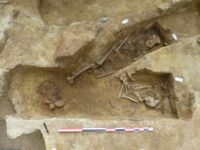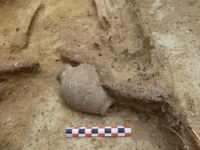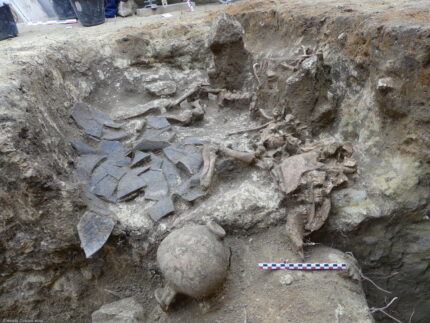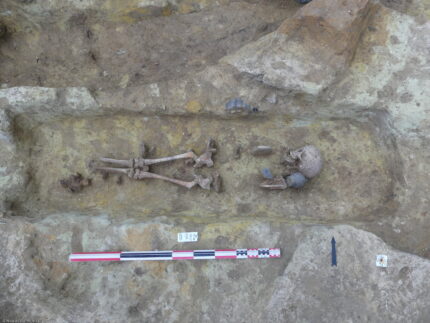 A preventative archaeology excavation before construction of a new subway station exit on the Left Bank in Paris has unearthed a large ground of burials dating to the 2nd century A.D. They were part of a necropolis on the outskirts of the ancient Gallo-Roman city of Lutetia, capital of the Parisii people.
A preventative archaeology excavation before construction of a new subway station exit on the Left Bank in Paris has unearthed a large ground of burials dating to the 2nd century A.D. They were part of a necropolis on the outskirts of the ancient Gallo-Roman city of Lutetia, capital of the Parisii people.
 A team of archaeologists from France’s National Institute of Preventive Archaeological Research (INRAP) discovered 50 inhumation burials of Parisii men, women and children buried in wooden coffins of which only the impressions of the planks and the iron nails are still present. (No cinerary burials were found, which is rare for the period.) The burials are densely packed with numerous overlaps. About half of the burials include grave goods like ceramic vessels (bowls, jugs, dishes) and glass vessels (balsamaria, lachrymatories, cups). A few coins, the obol to pay Charon’s fee for boating the dead over the River Styx, have been found in the mouth of the deceased. Shoes, their organic parts long-since decayed, have been found still in place, marked by the surviving hobnails embedded in the soles. Items of personal adornment — jewelry, belt buckles, hairpins — were recovered. One pit contained the complete skeleton of a pig and a second smaller animal believe to have been funerary sacrifices.
A team of archaeologists from France’s National Institute of Preventive Archaeological Research (INRAP) discovered 50 inhumation burials of Parisii men, women and children buried in wooden coffins of which only the impressions of the planks and the iron nails are still present. (No cinerary burials were found, which is rare for the period.) The burials are densely packed with numerous overlaps. About half of the burials include grave goods like ceramic vessels (bowls, jugs, dishes) and glass vessels (balsamaria, lachrymatories, cups). A few coins, the obol to pay Charon’s fee for boating the dead over the River Styx, have been found in the mouth of the deceased. Shoes, their organic parts long-since decayed, have been found still in place, marked by the surviving hobnails embedded in the soles. Items of personal adornment — jewelry, belt buckles, hairpins — were recovered. One pit contained the complete skeleton of a pig and a second smaller animal believe to have been funerary sacrifices.
 When it was in use, the necropolis was south of Lutetia, located on the outskirts of the city instead of within its walls, as was customary with burial grounds in antiquity. This southern necropolis developed along the Cardo Maximus, the main north-south thoroughfare of the Roman city. Lutetia’s Cardo Maximus is Paris’ busy Rue Saint-Jacques. Previous road works from the 19th and 20th centuries, including the construction of the subway line in 1970s, encountered the graves from the necropolis, but there was no systematic excavation. In the 19th century, burials were only scraped for grave goods deemed valuable before being reburied, leaving behind skeletal remains and other artifacts. The current section of the cemetery is not only intact and unexplored, but it has revealed a new map of the necropolis, far extending its western boundary.
When it was in use, the necropolis was south of Lutetia, located on the outskirts of the city instead of within its walls, as was customary with burial grounds in antiquity. This southern necropolis developed along the Cardo Maximus, the main north-south thoroughfare of the Roman city. Lutetia’s Cardo Maximus is Paris’ busy Rue Saint-Jacques. Previous road works from the 19th and 20th centuries, including the construction of the subway line in 1970s, encountered the graves from the necropolis, but there was no systematic excavation. In the 19th century, burials were only scraped for grave goods deemed valuable before being reburied, leaving behind skeletal remains and other artifacts. The current section of the cemetery is not only intact and unexplored, but it has revealed a new map of the necropolis, far extending its western boundary.
Unlike the excavation in the 1800s, this time the team plans to remove everything from the necropolis for analysis.
“This will allow us to understand the life of the Parisii through their funeral rites, as well as their health by studying their DNA,” [INRAP archaeologist Camille] Colonna said.
[INRAP president Dominique] Garcia said that the ancient history of Paris was “generally not well known”.
The unearthed graves open “a window into the world of Paris during antiquity,” he added.


What is a lachrymatory used for? Tears, evidently, but how, when, where and why?
They were actually unguentaria. Testing of trace residues inside of them has proved they contained fragrant unguents used in funerary rituals. The lachrymatory designation is grounded in a fanciful interpretation of their long, tube-like neck shapes. The name has just stuck as a description of this particular style of bottle. Ancient sources do record professional mourners weeping into bottles during funeral processions, but the bottles were not tear-catchers; they cried into the balsamaria/ungentaria used to anoint the body and prepare the grave.
Thank you.
Fascinating.